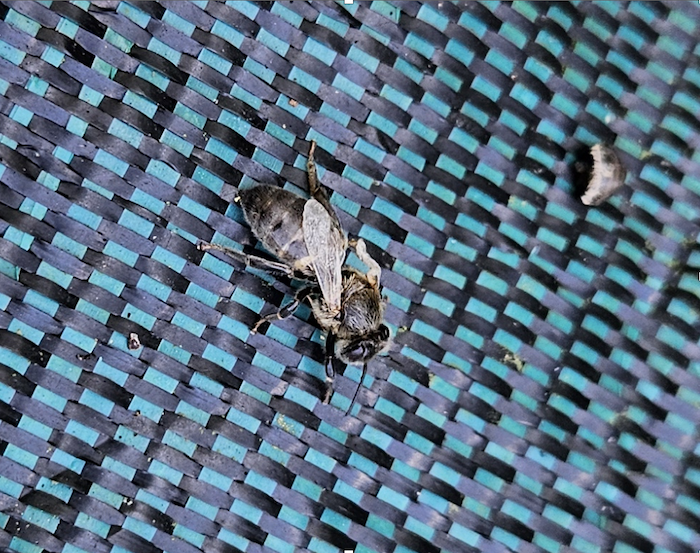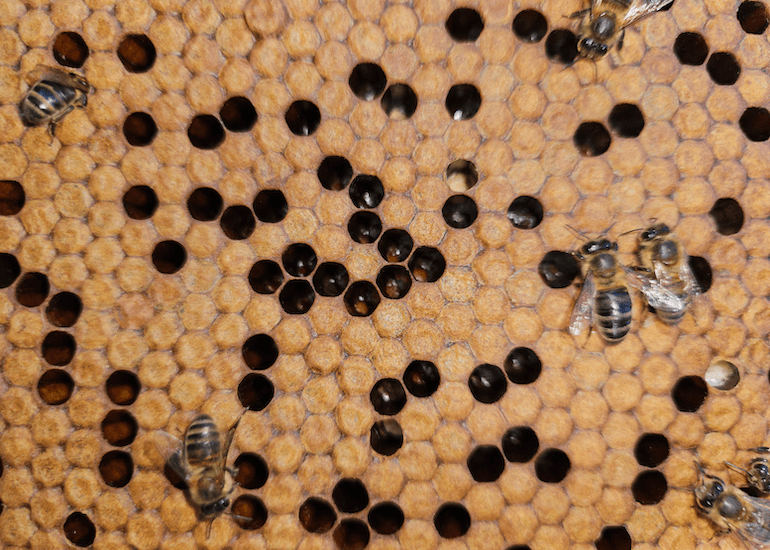 par Caroline Lantuejoul
par Caroline Lantuejoul This article presents a case study written by Dr Caroline Lantuejoul, a veterinarian specializing in beekeeping and apicultural pathologies in France. It describes a deteriorating health situation in an apiary, due to poorly controlled varroa mite pressure over an entire season, despite rigorous monitoring and management measures put in place by a hobby beekeeper.
Clinical examination revealed signs of residual mite pressure after the summer treatment, confirmed by further analysis. This case highlights the importance of constant varroa mite control, and of using control strategies adapted to the level of infestation in the colonies. It also highlights the impact of climate change on beekeeping practices, requiring ongoing adaptation to better manage varroa mite infestations and associated viral diseases.
She has been a hobby beekeeper for 10 years. At the end of winter 2024, 2 colonies were present in her apiary located in the countryside.
The beekeeper works with wooden Dadant hives and Nicot bottoms. Insulation (partition as roof insulation) is used depending on the time of year. A queen excluder is used systematically. Beekeeping practices are rigorous, with strict hygiene and monitoring measures. Colony monitoring is detailed and recorded in a health register. Bottoms are changed every spring. Equipment is cleaned (scraping or washing) and disinfected (flame or cold soda bath). Waxes are renewed regularly, and the years in which they were applied are noted on the frame heads to facilitate renewal with commercially available waxes (operculum wax).
Colonies are weighed regularly. A loss of almost 2 kg in weight per hive was recorded in early April. Substantial additions (syrup, fondant, protein patty) were made between February and May. These were estimated at between 5 and 6 kg of sugar per hive between February and May 2024. An artificial swarm was created on April 3, 2024 from 3 frames of brood from the R2 colony in spring 2024, which may partly explain the weight loss that was not quickly compensated for. Fertilization failed on the division and the colony became buzzing.
To combat varroa mites, beekeepers generally use two treatments a year (a summer treatment and a winter treatment): a long-acting solution at the end of the season (in summer) and a fast-acting solution in winter (when the brood is not present).
Below is the medication history and follow-up:
Varroa mite counts are carried out on the beehives on a regular basis. 38 days of counts were recorded in the beekeeper’s rearing register in 2024. A summary of the counts is given below.
Two crossbar frame for drone brood trapping were installed in 2024 with the aim of removing drone brood during the season to control varroa mites. A single removal of drone brood was recorded on March 19.
As a result of the high counts on sticky boards at the end of winter, 2 passages of treatment (liquid solution of oxalic acid) 1 week apart by dribbling were also carried out at the end of March 2024.
A visit was made to the remaining hive on September 24, 2024, following a varroa infestation deemed too high despite the varroa treatment applied during the summer.
During the visit, the hive is well maintained, as is the apiary. A field of mustard flowers is present at the rear of the apiary.
Colony inspection :
A protective tarpaulin is installed in front of the hives to optimize colony observation and apiary maintenance. Before the colonies were opened, 3 bees died on the tarpaulin at the foot of the hive. These bees had atrophied wings.


Samples for analysis :
Samples of asymptomatic indoor bees and brood were taken.
—
Bee virus memo :
DWV-A (Deformed Wing Virus type A): This virus is one of the most common and destructive to honey bees. It is often transmitted by the Varroa mite (Varroa destructor) and causes wing deformities, preventing bees from flying and reducing their life expectancy. DWV-B (Deformed Wing Virus type B): A variant of DWV-A, it is also transmitted by the varroa mite, but seems more virulent in certain contexts. Studies suggest that it may be more lethal to infested colonies. BQCV (Black Queen Cell Virus): This virus mainly affects queen larvae, leading to their death and the blackening of queen cells. It is often associated with stress and the presence of parasites such as the small hive beetle (Aethina tumida). SBV (Sacbrood Virus): Attacks honeybee brood and prevents normal larval development. Infected larvae take on a translucent, fluid-filled, sack-like appearance before dying. ABPV (Acute Bee Paralysis Virus): This virus causes rapid paralysis and death in adult bees, particularly those weakened by varroa mites. It often causes major losses in infested colonies. CBPV (Chronic Bee Paralysis Virus): CBPV causes hair loss on the abdomen, making affected bees appear shiny and black. Infected bees become unable to fly and eventually die in large numbers.
It therefore seems essential to adapt control measures according to the level of infestation of colonies as part of an integrated control strategy (medication and biotechnology).
For this reason, working on artificial brood-breaks (brood removal, queen caging, etc.) to optimize the efficacy of the treatments used, and adapting control measures to colony infestation, is becoming unavoidable.
Medication compliance is also an important issue. In the case described above, one of the strips fell off during the treatment period. The varroa falls measured by the beekeeper were divided by 2 over this period. The summer medication used was a contact treatment, and underdosing led to a delay in the effectiveness of the treatment. Colony activity is also essential to the efficacy of these contact medications.
Virus loads were also high, particularly for DWV-B and SBV.
___
Did you like this clinical case? Would you like to read more? Follow this link
 by Caroline Lantuejoul
by Caroline Lantuejoul  by Gérald Therville
by Gérald Therville Join the Véto-pharma community and receive our quarterly newsletter as well as our occasional beekeeping news. You can unsubscribe at any time if our content does not suit you, and your data will never be transferred to a third party!
© 2019-2025, Véto-pharma. All rights reserved